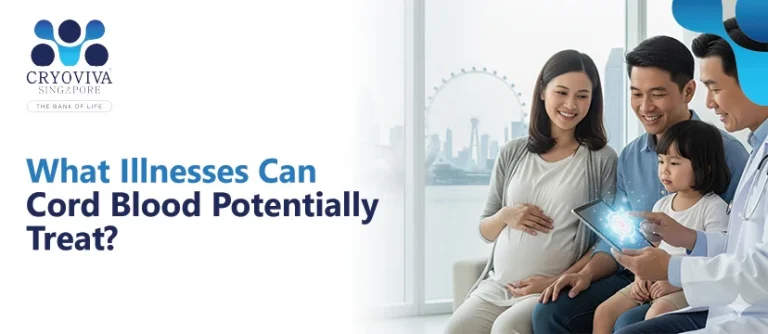Blog
What Illnesses Can Cord Blood Potentially Treat?

‘Illness’ might sound like a simple word, but its meaning extends far beyond just feeling unwell. It’s when your body and mind are affected and an organ stops working the way it should. While short-term illnesses like cold come and go, some long-term conditions don’t. Conditions like anemia or certain immune disorders don’t just disappear on their own. They can impact your and your child’s health, dreams, and even your family’s financial stability, keeping you in constant stress.
But what if you could make the best decision to protect your child’s and family’s future today? That’s where cord blood banking in Singapore comes in.
When your baby is born, their umbilical cord holds potent stem cells. These cells have the unique ability to treat around 80 serious diseases, from blood disorders to immune disorders. By preserving your baby’s cord blood in a family or private bank like Cryoviva Singapore, you create a safety net, ready for when life throws unexpected health challenges your way.
Learn more about the many illnesses treated by cord blood in this blog.
Illnesses That Cord Blood Can Potentially Manage
Here is the list of some illnesses that cord blood can help with. Explore to know.
-
Blood cancers
- Acute Lymphoblastic Leukemia (ALL): It is one of the common childhood blood cancers. Stem cells present in cord blood can help replace the unhealthy blood cells with healthy cells.
- Acute Myelogenous Leukemia (AML): It is a fast-spreading cancer of the blood and bone marrow. Cord blood stem cells have the potential to rebuild the immune system after chemotherapy.
- Chronic Myelogenous Leukemia (CML): It is a slower-growing blood cancer. Cord blood can help produce healthy blood cells when other treatments fail or are ineffective.
-
Other Blood Disorders
- Sickle Cell Disease: An inherited red blood cell problem leading to pain and fatigue. Cord blood transplants can give an individual healthy cells to substitute damaged ones.
- Beta Thalassaemia Major: A genetic anaemia or low blood count condition causing tiredness and slowed growth. Cord blood stem cells can support people by making new healthy blood cells.
- Aplastic Anaemia: It is a condition where bone marrow fails to make blood cells. Cord blood transplants have the potential to “restart” blood cell production.
-
Lymphomas & Bone Marrow Cancers
- Hodgkin’s Lymphoma: A blood cancer that targets immune cells. Cord blood gives new and healthy cells to rebuild the immune system after therapy.
- Non-Hodgkin’s Lymphoma: It is also a type of blood cancer. Cord blood can exchange cancerous cells with healthy immune cells.
- Multiple Myeloma: A cancer of plasma cells in bone marrow. Cord blood carries the potential to restore normal cell production after intensive treatment.
-
Genetic Disorders
- Fanconi Anemia: A rare inherited disorder that leads to bone marrow failure. Cord blood supplies stem cells to restore blood production.
- Severe Combined Immunodeficiency (SCID): It is also called “bubble boy disease” and causes a very weak immune system. Cord blood stem cells can support rebuilding of immunity.
- Diamond-Blackfan Anemia: A genetic problem reduces the body’s ability to make red blood cells. Cord blood can help correct this and improve overall health.
-
Other Treatable Diseases
- Hurler Syndrome (MPS-IH): A metabolic disorder that leads to organ damage. Cord blood can help slow or prevent symptoms by replacing defective cells.
- Neuroblastoma: It is a childhood cancer of nerve cells. Cord blood is used after intensive treatments to restore healthy blood and immune cells.
- Retinoblastoma: A rare eye cancer affecting children. Cord blood helps restore healthy cell production after vigorous treatment.
Note: Cord blood stem cells are not the sole treatment or a cure by themselves for the diseases mentioned above. It may carry the potential to be part of a full treatment plan and could help, along with other medical therapies. Always follow your doctor’s instructions and treatment guidelines for any health conditions and illnesses.
Conclusion
Cord blood stem cells can help treat neurological issues in children like autism, cerebral palsy, and several other diseases. Young children, especially those under five who can already walk, are reported to benefit most. In Singapore, more and more parents are now opting for private cord blood banking with Cryoviva Singapore for future health support. Don’t wait; safeguard your child’s health by conserving their cord blood at birth with us.
FAQs
1. Can cord blood cure leukemia or genetic disorders?
Cord blood has the potential to be part of a bigger treatment plan for some types of leukemia and certain genetic disorders through stem cell transplants.
2. Is cord blood useful for future medical emergencies?
Yes, storing cord blood can be useful for future medical emergencies. It offers an extra option for treating future illnesses, specifically certain blood diseases and immune problems.
3. What happens to cord blood after 18 years?
The policies may depend on the country you live in. But, usually, after 18 years, the cord blood unit is still stored safely. The child (now adult) can decide what to do with it: keep storing, utilising, or donate it, as per the bank’s policies.


